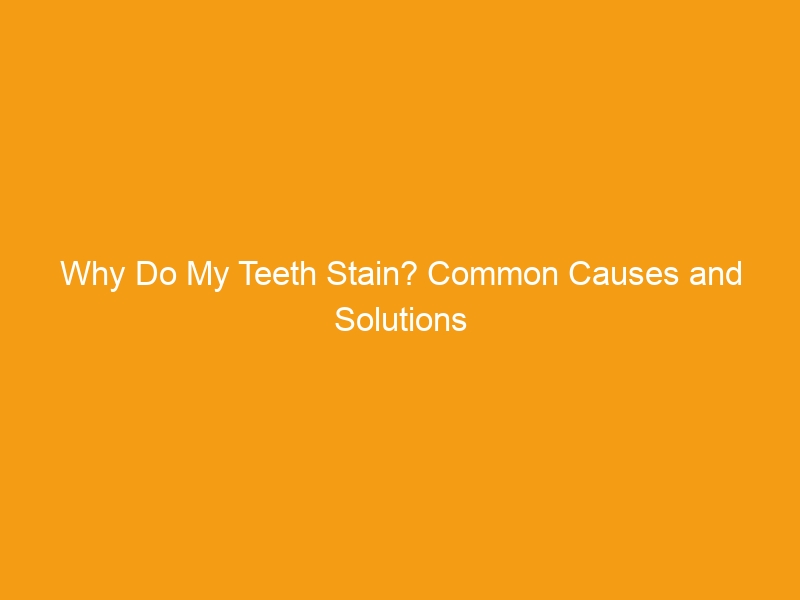Introduction
Teeth staining is a common issue that many people face, often leaving them self-conscious about their smile. The reasons for teeth stains can be varied, from dietary habits to aging. This article explores the common causes of teeth staining and provides practical solutions to help you maintain a radiant smile.
Types of Teeth Stains
Understanding the type of teeth stains is essential to determine the suitable treatment. Teeth stains are generally categorized into two types: intrinsic and extrinsic.
Intrinsic Stains
Intrinsic stains occur within the tooth structure and are often caused by certain medications, excessive fluoride exposure during childhood, or trauma to the teeth. It’s important to note that intrinsic stains can be more challenging to remove.
Extrinsic Stains
On the other hand, extrinsic stains are external and affect the surface of the teeth. Common causes include foods, beverages, and tobacco use. These stains are generally easier to manage and can often be treated with professional cleaning or whitening products like Parkesburg teeth whitening.
Common Causes of Teeth Staining
There are numerous factors contributing to teeth staining. Being aware of these can help you take preventive measures.
Foods and Beverages
Certain foods and drinks are notorious for staining teeth. Common culprits include coffee, tea, red wine, berries, soy sauce, and tomato sauce. The chromogens and tannins in these items stick to the enamel, causing discoloration.
Tobacco Use
Smoking or chewing tobacco is another major cause of teeth staining. The nicotine and tar in tobacco products create stubborn yellow or brown stains that can penetrate the enamel, making them difficult to remove.
Poor Oral Hygiene
Neglecting proper oral hygiene can lead to plaque buildup, which turns into tartar, which stains teeth. Daily brushing and flossing are crucial to preventing such buildup and subsequent staining.
Aging
Our teeth’ outer layer of enamel wears away as we age, exposing the yellowish dentin beneath. This natural process can lead to a more yellowed appearance of the teeth over time.
Medications
Certain medications, such as tetracycline antibiotics and antihistamines, can lead to intrinsic teeth staining. Treatments like chemotherapy and radiation can also contribute to discoloration.
Genetics
Genetics play a role in the natural color and thickness of your enamel. Some individuals may have naturally thinner or more translucent enamel, making their teeth appear yellow or prone to staining.
Effective Solutions
Fortunately, multiple solutions are available for dealing with teeth stains, from simple home remedies to professional treatments.
Professional Teeth Whitening
One of the most effective ways to combat teeth stains is through professional teeth whitening treatments. These treatments use more vital bleaching agents to remove intrinsic and extrinsic stains. Consult your dentist to determine the best options for your needs.
Whitening Toothpaste and Products
Over-the-counter whitening toothpaste and strips can help manage extrinsic stains. These products usually contain mild abrasives and peroxide compounds that can effectively remove surface stains with regular use.
Natural Remedies
Natural remedies such as baking soda and hydrogen peroxide mixtures can also help lighten teeth stains. Another popular natural option is activated charcoal, but it’s essential to use it sparingly as it can be abrasive to enamel.
Regular Dental Cleanings
Scheduling regular dental cleanings is crucial for maintaining white teeth. Professional cleanings remove stubborn plaque and tartar that at-home brushing and flossing may miss.
Dietary Changes
Limit the intake of stain-causing foods and beverages. If you consume them, rinse your mouth with water afterward. Additionally, using a straw for beverages like coffee, tea, and soda can help minimize their contact with your teeth.
Quit Smoking
Reducing or quitting tobacco use can significantly improve the appearance of your teeth. This will benefit your oral health and positively impact your overall well-being.
Maintenance Tips
Maintaining your whitened smile requires consistent care and good habits.
Brush and Floss Regularly
Brushing at least twice daily and flossing daily are fundamental in preventing plaque buildup. Use a toothpaste containing fluoride to strengthen your enamel and prevent decay.
Use Mouthwash
Incorporate an antibacterial mouthwash into your routine to reduce plaque and keep your breath fresh. Some mouthwashes also contain whitening agents that can help maintain your white smile.
Consume a Balanced Diet
A balanced diet of fruits, vegetables, and calcium can promote healthy teeth and gums. Foods like apples, carrots, and celery can be natural teeth cleaners.
Regular Dental Check-Ups
It is vital to visit your dentist regularly for check-ups and cleanings. Your dentist can provide professional advice and early intervention if dental issues arise.
Teeth Whitening Touch-Ups
Depending on the whitening method you choose, you may need touch-up treatments. Consult your dentist to determine how often you should undergo these treatments to maintain your desired level of whiteness.
Conclusion
Teeth staining can be frustrating, but understanding its causes and knowing how to address it can make a significant difference. Maintaining a bright smile is achievable with the right approach, whether through professional treatments or simple lifestyle changes. By remaining diligent with your oral hygiene and being mindful of your dietary habits, you can enjoy a whiter, more confident smile.

